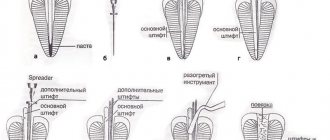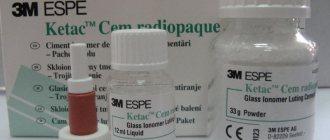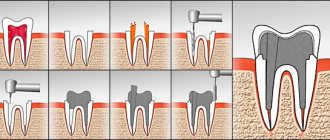Root canal treatment is carried out during endodontic treatment. This manipulation is performed to prevent the spread of the infectious process to the surrounding periodontal tissue. At the World of Dentistry clinic, specialists use modern methods of root canal treatment, which make it possible to save even a severely damaged unit.
Several decades ago, dental canal treatment was accompanied by quite severe discomfort. Today this procedure is performed under local anesthesia using high-quality effective drugs. Root canal therapy is required when there is inflammation or infection to save the unit. Our specialists resort to tooth extraction in the most extreme cases. After cleaning the dental canals, the unit will last for another year.
Stages of root canal treatment
- Providing access to canal mouths:
- Formation of cavities in the tooth of the correct size, shape and in a certain quantity.
- Cleaning the tooth from tissues affected by caries and removing old fillings. Endobors are used for this purpose.
Endoburs are cylindrical or cone-shaped heads made of hard alloys or diamond chips.
- Expansion of the mouths of the dental canals. This stage ensures the convenience of the procedure and involves the formation of a funnel-shaped entrance to the root canal.
- Extraction of the contents of dental canals. The pulp is completely removed using special pulp extractors:
- The pulp extractor is slowly placed into the canal until the instrument begins to come into contact with its walls.
- After this, the pulp extractor is rotated 360 degrees. In this way, the nerve bundle is captured and removed. Normally, the pulp should be completely removed.
- The channels are treated with an antiseptic solution. Evaluation criteria: the pulp from the canal is completely removed, there is a free lumen of the canal.
- Determination of the working length of the root canal. For this purpose, root needles or special endodontic rulers are used. It is necessary to measure the working length of the canal in order not to damage the periapical tissue. The working length is the distance from the highest point of the dental crown to the beginning of the narrowing of the canal. This indicator can be determined in three ways:
- Estimated length of tooth and root.
- Using radiography.
- Electrometric method.
Special tables containing the minimum, average and maximum dimensions of tooth length help determine the length of the dental canal.
- Mechanical treatment of root canals. It consists of processing them with special tools and subsequent expansion to the required size.
- Canal filling. Gutta-percha is usually used for this.
Features of trephination of the crowns of different teeth
The method of opening the dental crown to gain access to the root canals is determined by the topographic anatomy, characteristic and confirmed by radiographs for a particular tooth. Trephination of lower two-channel incisors is most often carried out with the removal of the cutting edge. The opening of the cavity of the frontal teeth of the upper row is usually performed from the inner (oral) surface. Premolars are prepared by drilling a hole in the middle of the crown, and preparation of molars for treatment begins from the mesial zone of the chewing surface. It is necessary to take into account that temporary and permanent children’s teeth have a very large pulp cavity. This requires wide opening and removal of large amounts of tissue. Another important point is the size of the trepanation access point. In the case of temporary teeth, it should be less than when processing permanent teeth.
Mechanical treatment of root canals
The main task of mechanical treatment of dental canals is their expansion for the purpose of high-quality filling. If mechanical treatment is not carried out, the channel will be heterogeneous, having narrowings and expansions. This factor will become an obstacle to completely filling the canal with filling material.
Mechanical treatment of dental canals can be carried out in two ways:
- Using hand tools. The method involves placing medical devices into the root canal and gently rotating them.
- Using an endodontic handpiece. Special profile files made of nickel-titanium are placed in the tips. Under the influence of the tip, the pro-file rotates in the channel, and its sharp edges remove chips from the walls of the channel, making it wider. The advantage of pro files is the so-called shape memory. Thanks to this feature, the instruments do not break even in very curved canals. This eliminates the risk of serious complications associated with a piece of dental instrument remaining in the canal.
Benefits of using an endodontic handpiece
- Compared to the use of hand instruments, the endodontic handpiece provides better treatment of the canals. After machine processing, the canal walls become very smooth. This allows for easy insertion of gutta-percha filling pins.
- Treatment with an endodontic handpiece takes significantly less time compared to manual treatment.
- The technique is safe. Typically, the handpieces are equipped with a micromotor that controls the rotation of the pro-file in the dental canal. If the permissible load is exceeded, the micromotor stops the rotation of the pro-file. Thus, there is no risk of tool breakage, which cannot be guaranteed with manual processing. Not every doctor can feel the extreme resistance at which the instrument may break.
Our clinic uses machine processing using “smart” instruments. The processing is carried out by top-level specialists. Therefore, we can guarantee the safety of the procedure.
What can be seen in the photo?
The canal must be completely sealed, that is, to the top - the material in this case is highlighted in a bright white color, which should be filled to its entire length.
It should not only be filled to its entire length, but also have no gaps on the sides - this means that the material should be tightly obturated. The image should not show pieces of hanging gutta-percha, smeared material or dark gaps.
By following all stages of filling, you can avoid tooth inflammation. Otherwise, you will have to waste a lot of time and effort restoring the lost tooth.
Treatment of canals using chemicals
Chemical treatment is used when mechanical cleaning is not possible. Usually the procedure is performed using chemicals when the canals are too narrow or completely impassable. After chemical treatment, mechanical treatment can be carried out.
Previously, nitric and hydrochloric acids were used for the procedure. But later they abandoned these substances, since they burned the surrounding tooth tissues when they got on them. Today, calcium salts and chelating agents are used. They can be in liquid or gel form. Solutions of calcium salts penetrate well into narrow channels. The advantage of these substances is their antiseptic property. In addition, they contain EDTA, which provides good glide for instruments. Chemical treatment is carried out in several stages:
- The cavity in the tooth is thoroughly dried.
- A solution is placed in it and injected.
- After penetration of the chemical, the channel is expanded mechanically.
Solutions do not have a negative effect on surrounding tissues. Drugs must meet the following requirements:
- Have a bactericidal effect.
- Do not damage surrounding tissues upon contact.
- Do not cause allergies.
- Do not cause resistance in microorganisms.
- Have a quick effect.
- Be active in the presence of organic compounds.
- Do not have a strong odor.
Today it is almost impossible to select a substance that will meet all of the above requirements. The most popular drug used in dentistry for root canal treatment is sodium hypochloride. It is effective, has broad bactericidal activity, thanks to which it protects the tooth from various microorganisms.
After the treatment, filling is performed. For this purpose, high-quality materials are also selected that will retain their shape and volume in the canal cavity. This property will provide reliable protection against bacterial infection.
Diseases that require endodontic therapy
Treatment of tooth canals is performed only if there are strict indications, since as a result of the intervention, the tooth is deprived of the vessels and nerve endings that feed it, which makes the dental tissues less durable and more susceptible to destruction. Indications for intervention include inflammation and infections accompanying caries or traumatic tooth damage:
- Pulpitis is inflammation of the pulp (neurovascular tissue) - soft, fibrous tissue, including blood and lymphatic vessels, nerve endings and connective tissue.
- Periodontitis is inflammation of the tooth root and surrounding tissues (periodontal tissue).
These diseases are usually accompanied by the following symptoms:
- Acute, throbbing or aching pain in the tooth, increasing at night or intensifying with load on the tooth.
- Swelling, discoloration of the gums, formation of ulcers and fistulas on it.
- Putrid odor from the mouth.
In some cases, there are no pronounced symptoms and the development of pulp necrosis is detected only during a doctor’s examination. Only a specialist can accurately determine whether endodontic treatment will solve the problem and select the most effective therapeutic regimen.
Contraindications to root canal treatment
The procedure has a number of contraindications:
- Hypertension during a crisis.
- Diabetes in the stage of decompensation.
- Diseases of the immune system.
- Severe osteoporosis.
- Respiratory infections.
If you are taking medications to thin your blood, you should tell your doctor. In this case, the specialist may prescribe a two-day medication break. If there is a contraindication to the treatment of dental canals, then tooth extraction and prosthetics on an implant can be performed.
Recommendations for recovery
After completing the procedure, you must follow the recommendations:
- Do not eat food for 2-3 hours. This is because the treatment area will not be sensitive and you may accidentally damage it while eating.
- For the first few days, do not eat solid foods.
- Take a course of antibiotics if prescribed by your doctor.
- Clean your mouth regularly and thoroughly.
- Place a permanent filling in a timely manner if, after the procedure, the canal was filled with temporary material. If the temporary filling becomes too thin, you should consult a doctor.
In most cases, one week is enough for the rehabilitation period. During this period, the oral cavity is completely restored. In the first 2-3 days, quite intense pain may be observed. During this period, you should take painkillers that are recommended by a specialist. Cephallosporin antibiotics are usually prescribed for a course of 5-7 days.
For high-quality root canal treatment, contact the World of Dentistry clinic. Our undeniable advantage is qualified dentists and the optimal cost of services.
How to check the quality of canal filling?
Quality control of fillings is an integral part of the treatment process and is performed at every stage. X-ray control is especially important after filling. It allows you to identify areas of insufficiently dense obturation, detect pins or sealer residues protruding beyond the root apex, identify fragments of files and other defects. All this can lead to severe pain after treatment, as well as to the development of complications.
The x-ray image should clearly show the canal cavities, densely filled with filling material. There should be no enlightenment. The filling material should reach the very top of the canal.
Following simple rules of prevention also helps to avoid complications. Pain after treatment can last from several days to a month and does not always indicate ineffectiveness or low quality of treatment. However, if they appear, you should consult your dentist. Also, after treatment, it is recommended to abstain for some time from physical activity, drinking alcohol, and eating hot and spicy foods.
To prevent pulpitis, carefully monitor your oral hygiene. Use only professional products. If during the day you do not have the opportunity to brush your teeth after eating, use Asepta Fresh mouthwash. It disinfects the oral cavity, effectively fights caries, and normalizes acidity.











